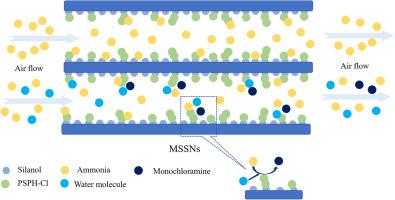Journal of Environmental Chemical Engineering ( IF 7.4 ) Pub Date : 2020-12-04 , DOI: 10.1016/j.jece.2020.104900 Yingfeng Wang , Joonhoo Jung , Jianchuan Wen , Xuehong Ren , Yuyu Sun

|
Ammonia emission causes serious threats to human and environmental health, particularly in developing countries. In this work, the reactions of ammonia with two monomeric N-halamines, 1-chloro-5,5–dimethylhydantoin (MCDMH) and 1-chloro-2,2,5,5-tetramethyl-4-imidazolidinon (MC) in aqueous solution, and mesoporous silica-supported N-halamines (MSSNs) in aqueous and gaseous phase were investigated. For MCDMH (amide-based N-halamine), about 100% ammonia in aqueous solution was reduced under low molar ratio (Cl: N, 4:1) directly, which is 30% higher than MC (amine-based N-halamine). Nitrogen gas was the major product in the reaction between monomeric N-halamine and ammonia. In the case of MSSNs, up to 90% of ammonia (10 ppm, 10 mL) in aqueous solution could be reduced, and the major reaction product was monochloramine instead of nitrogen gas. In gaseous phase, MSSNs rapidly absorbed ammonia physically, and the N-halamines decomposed the absorbed ammonia under wet condition. These results point to the great potentials of MSSNs as good candidates to “catch” and decompose ammonia for a broad range of applications.









































 京公网安备 11010802027423号
京公网安备 11010802027423号